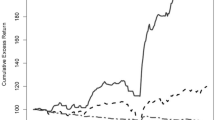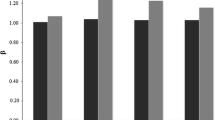Abstract
We propose a novel approach to measure risk in fixed income portfolios in terms of value-at-risk (VaR). We obtain closed-form expressions for the vector of expected bond returns and for its covariance matrix based on a general class of dynamic factor models, including the dynamic versions of the Nelson-Siegel and Svensson models, to compute the parametric VaR of a portfolio composed of fixed income securities. The proposed approach provides additional modeling flexibility as it can accommodate alternative specifications of the yield curve as well as alternative specifications of the conditional heteroskedasticity in bond returns. An empirical application involving a data set with 15 fixed income securities with different maturities indicate that the proposed approach delivers accurate VaR estimates.

Similar content being viewed by others
Notes
All models are estimated using a recursive expanding estimation window. Departing from the first 500 observations, all models are estimated and their corresponding one-step-ahead VaR estimated are obtained using (17). Next, we add one observation to the estimation window and re-estimate all models and obtain another one-step-ahead estimate of the VaR. This process is repeated until the end of the data set is reached. In this way, we obtain 486 out-of-sample one-step-ahead VaR forecasts. All results discussed in Sect. 4.2 are based solely on out-of-sample observations.
A review of issues related to the estimation of univariate GARCH models, such as the choice of initial values, numerical algorithms, accuracy, and asymptotic properties are given by Berkes et al. (2003), Robinson and Zaffaroni (2006), Francq and Zakoian (2009) and Zivot (2009). It is important to note that even when the normality assumption is inappropriate, the QML estimator of univariate GARCH models based on maximizing the Gaussian likelihood is consistent and asymptotically normal, provided that the conditional mean and variance of the GARCH model are correctly specified, see Bollerslev and Wooldridge (1992).
The DI-futuro rate is the average daily rate of Brazilian interbank deposits (borowing/lending), calculated by the Clearinghouse for Custody and Settlements (CETIP) for all business days. The DI-futuro rate, which is published on a daily basis, is expressed in annually compounded terms, based on 252 business days. When buying a DI-futuro contract for the price at time \(t\) and keeping it until maturity \(\tau \), the gain or loss is given by:
$$\begin{aligned} 100.000\left( \frac{\prod _{i=1}^{\zeta (t,\tau )}(1+y_i)^{\frac{1}{252}}}{(1+DI^*)^{\frac{\zeta (t,\tau )}{252}}}-1\right) , \end{aligned}$$where \(y_i\) denotes the DI-futuro rate, \((i-1)\) days after the trading day. The function \(\zeta (t,\tau )\) represents the number of working days between t and \(\tau \).
References
Almeida, C., & Vicente, J. (2009). Are interest rate options important for the assessment of interest rate risk? Journal of Banking & Finance, 33(8), 1376–1387.
Andersen, T., Bollerslev, T., Christoffersen, P., & Diebold, F. (2006). Volatility and correlation forecasting. In G. Elliott, C. W. J. Granger, & A. Timmermann (Eds.), Handbook of Economic Forecasting. Oxford: Elsevier.
Andersen, T. G., & Benzoni, L. (2010). Stochastic volatility. CREATES Research Papers 2010–10, School of Economics and Management, University of Aarhus.
Bauwens, L., Laurent, S., & Rombouts, J. (2006). Multivariate GARCH models: a survey. Journal of Applied Econometrics, 21(1), 79–109.
Berkes, I., Horváth, L., & Kokoszka, P. (2003). GARCH processes: structure and estimation. Bernoulli, 9(2), 201–227.
Berkowitz, J., & O’Brien, J. (2002). How accurate are value-at-risk models at commercial banks? The Journal of Finance, 57(3), 1093–1111.
Bianchi, F., Mumtaz, H., & Surico, P. (2009). The great moderation of the term structure of uk interest rates. Journal of Monetary Economics, 56(6), 856–871.
BIS. (2005). Zero-coupon yield curves: technical documentation. Technical Report. Bank for International Settlements.
Bollerslev, T. (1986). Generalized autoregressive conditional heteroskedasticity. Journal of Econometrics, 31(3), 307–327.
Bollerslev, T. (1990). Modelling the coherence in short-run nominal exchange rates: a multivariate generalized ARCH model. Review of Economics and Statistics, 72(3), 498–505.
Bollerslev, T., & Wooldridge, J. (1992). Quasi-maximum likelihood estimation and inference in dynamic models with time-varying covariances. Econometric reviews, 11(2), 143–172.
Brooks, C., & Persand, G. (2003). Volatility forecasting for risk management. Journal of Forecasting, 22(1), 1–22.
Cappiello, L., Engle, R., & Sheppard, K. (2006). Asymmetric dynamics in the correlations of global equity and bond returns. Journal of Financial Econometrics, 4(4), 537–572.
Chib, S., Omori, Y., & Asai, M. (2009). Multivariate Stochastic Volatility. Berlin: Springer.
Christoffersen, P. (1998). Evaluating interval forecasts. International Economic Review, 39(4), 841–862.
Christoffersen, P., Hahn, J., & Inoue, A. (2001). Testing and comparing value-at-risk measures. Journal of Empirical Finance, 8(3), 325–342.
De Pooter, M. (2007). Examining the nelson-siegel class of term structure models. Tinbergen Institute Discussion Papers. Amsterdam: Tinbergen Institute.
De Goeij, P., Marquering, W. (2006). Macroeconomic announcements and asymmetric volatility in bond returns. Journal of Banking & Finance 30(10):2659–2680.
DeMiguel, V., Garlappi, L., & Uppal, R. (2009). Optimal versus naive diversification: how inefficient is the 1/N portfolio strategy? Review of Financial Studies, 22(5), 1915–1953.
Diebold, F., Li, C. (2006). Forecasting the term structure of government bond yields. Journal of Econometrics 130(2):337–364.
Diebold. F. X., Rudebusch, G. D. (2011). The Dynamic Nelson-Siegel approach to yield curve modeling and forecasting. Mimeo.
Diebold, F. X., Rudebusch, G. D., Aruoba, S. B. (2006). The macroeconomy and the yield curve: a dynamic latent factor approach. Journal of Econometrics 131(1–2):309–338.
Ding, Z., Granger, C., & Engle, R. (1993). A long memory property of stock returns and a new model. Journal of Empirical Finance, 1(1), 83–106.
Engle, R. (1990). Stock volatility and the crash of ’87: discussion. The Review of Financial Studies, 3(1), 103–106.
Engle, R. (2002). Dynamic conditional correlation: a simple class of multivariate generalized autoregressive conditional heteroskedasticity models. Journal of Business & Economic Statistics, 20(3), 339–350.
Engle, R., Kelly, B. (2009). Dynamic equicorrelation. NYU Working Paper No. FIN-08-038.
Engle, R., & Manganelli, S. (2004). CAViaR: conditional autoregressive value at risk by regression quantiles. Journal of Business & Economic Statistics, 22(4), 367–382.
Engle, R., & Ng, V. (1993). Measuring and testing the impact of news on volatility. Journal of Finance, 48(5), 1749–78.
Engle, R., Sheppard, K. (2001). Theoretical and empirical properties of dynamic conditional correlation multivariate GARCH. NBER Working Paper W8554.
Engle, R., Shephard, N., & Sheppard, K. (2008). Fitting vast dimensional time-varying covariance Models. Discussion Paper Series n403. Oxford: Department of Economics, University of Oxford.
Ferreira, M. (2005). Forecasting the comovements of spot interest rates. Journal of International Money and Finance, 24(5), 766–792.
Ferreira, M., & Lopez, J. (2005). Evaluating interest rate covariance models within a value-at-risk framework. Journal of Financial Econometrics, 3(1), 126–168.
Francq, C., & Zakoian, J. (2009). A tour in the asymptotic theory of GARCH estimation. In T. Andersen, R. Davis, J. P. Kreiss, & T. Mikosch (Eds.), Handbook of Financial Time Series. Berlin: Springer.
Galeano, P., & Ausin, M. (2010). The gaussian mixture dynamic conditional correlation model: Parameter estimation, value at risk calculation, and portfolio selection. Journal of Business & Economic Statistics, 28(4), 559–571.
Giacomini, R., & White, H. (2006). Tests of conditional predictive ability. Econometrica, 74(6), 1545–1578.
Gimeno, R., Nave, J. M. (2009). A genetic algorithm estimation of the term structure of interest rates. Computational Statistics & Data Analysis 53(6):2236–2250.
Giot, P., & Laurent, S. (2004). Modelling daily value-at-risk using realized volatility and ARCH type models. Journal of Empirical Finance, 11(3), 379–398.
Glosten, L., Jagannathan, R., & Runkle, D. (1993). On the relation between the expected value and the volatility of the nominal excess return on stocks. Journal of Finance, 48, 1779–1801.
Hagan, P., & West, G. (2006). Interpolation methods for curve construction. Applied Mathematical Finance, 13(2), 89–129.
Harvey, A., Ruiz, E., & Shephard, N. (1994). Multivariate stochastic variance models. Review of Economic Studies, 61(2), 247–64.
Haustsch, N., & Ou, Y. (2012). Bayesian inference in a stochastic volatility nelson-siegel model. Computational Statistics and Data Analysis, 56(11), 3774–3792.
Hayden, J., & Ferstl, R. (2010). Zero-coupon yield curve estimation with the package termstrc. Journal of Statistical Software, 36(i01), 1–34.
Jones, C. M., Lamont, O., Lumsdaine, R. L. (1998). Macroeconomic news and bond market volatility. Journal of Financial Economics 47(3):315–337.
Jungbacker, B., Koopman, S. (2008). Likelihood-based analysis for dynamic factor models. Tinbergen Institute Discussion Paper Found on http://www.tinbergen.nl. Accessed 1 May 2013.
Koopman, S. J., Mallee, M. I., & van der Wel, M. (2010). Analyzing the term structure of interest rates using the dynamic nelson-siegel model with time-varying parameters. Journal of Business and Economic Statistics, 28(3), 329–343.
Litterman, R., & Scheinkman, J. (1991). Common factors affecting bond returns. Journal of Fixed Income, 1(1), 54–61.
McAleer, M. (2009). The ten commandments for optimizing value-at-risk and daily capital charges. Journal of Economic Surveys, 23(5), 831–849.
McCulloch, J. H. (1971). Measuring the term structure of interest rates. The Journal of Business, 44(1):19–31.
McCulloch, J. H. (1975). The tax-adjusted yield curve. Journal of Finance 30(3):811–30.
Nelson, C. R. N., & Siegel, A. F. (1987). Parsimonious modeling of yield curves. The Journal of Business, 60(4), 473–489.
Nelson, D. (1991). Conditional heteroskedasticity in asset returns: a new approach. Econometrica, 59(2), 347–370.
Poon, S., & Granger, C. (2003). Forecasting Volatility in Financial Markets: A Review. Journal of Economic Literature, 41(2), 478–539.
Rezende, R. B., & Ferreira, M. S. (2011). Modeling and forecasting the yield curve by an extended nelson-siegel class of models: A quantile autoregression approach. Journal of Forecasting, 30(8), 339–350.
Robinson, P., & Zaffaroni, P. (2006). Pseudo-maximum likelihood estimation of ARCH(\(\infty \)) models. The Annals of Statistics, 34(3), 1049–1074.
Santos, A. A. P., & Moura, G. V. (2012). Dynamic factor multivariate garch model. Forthcoming, Computational Statistics and Data Analysis, 53, 2309–2324.
Santos, A. A. P., Ruiz, E., Nogales, F., & Van Dijk, D. (2012). Optimal portfolios with minimum capital requirements. Journal of Banking and Finance, 36, 1928–1942.
Santos, A. A. P., Nogales, F., & Ruiz, E. (2013). Comparing univariate and multivariate models to forecast portfolio value-at-risk. Journal of Financial Econometrics, 11(3), 400–441.
Sheppard, K. (2003). Multi-step estimation of multivariate GARCH models. In Proceedings of the International ICSC. Symposium: Advanced Computing in Financial Markets. Salt Lake: ICSC.
Svensson, L. O. (1994). Estimating and interpreting forward interest rates: Sweden 1992–1994. IMF Working Papers 94/114, International Monetary Fund, http://ideas.repec.org/p/imf/imfwpa/94-114.html. Accessed 1 May 2013.
Vlaar, P. (2000). Value at risk models for dutch bond portfolios. Journal of banking & finance, 24(7), 1131–1154.
Zaffaroni, P. (2007). Contemporaneous aggregation of GARCH processes. Journal of Time Series Analysis, 28(4), 521–544.
Zakoian, J. (1994). Threshold heteroskedastic models. Journal of Economic Dynamics and control, 18(5), 931–955.
Zivot, E. (2009). Practical issues in the analysis of univariate GARCH models. In R. Davis, J. P. Kreiss, & T. Mikosch, T. Andersen (Eds.), Handbook of financial time series. New York: Springer Verlag.
Author information
Authors and Affiliations
Corresponding author
Rights and permissions
About this article
Cite this article
Caldeira, J.F., Moura, G.V. & Santos, A.A.P. Measuring Risk in Fixed Income Portfolios using Yield Curve Models. Comput Econ 46, 65–82 (2015). https://doi.org/10.1007/s10614-014-9438-7
Accepted:
Published:
Issue Date:
DOI: https://doi.org/10.1007/s10614-014-9438-7




